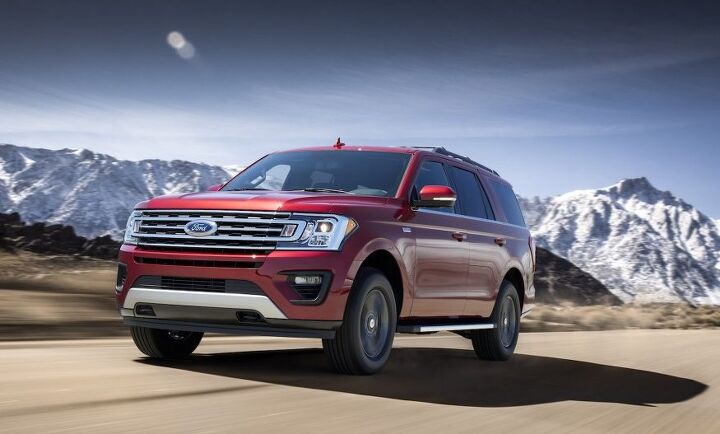The New Thriftpower? EPA Says Less-thirsty 2018 Ford Expedition Tops Its Class

There’s nothing quite as uncertain as that little number staring at you from the window sticker of a new vehicle. It’s two digits long (unless you’re fabulously rich), followed by the word “combined.” We’re talking, of course, about the Environmental Protection Agency’s fuel economy rating, which often turns out to be an impossible-to-reach goal or — if you’re lucky — a lowballed figure.
Back in the days of lapels and flares, the hot gas mileage action was found in the compact and subcompact class. Economy cars, after all. Well, people these days prefer driving a vehicle that seats at least five adults in comfort while towing a boat and hauling 65 pounds of kid’s toys and a dog in the rear cargo area. With the heyday of the cheap little car long gone, the (fuel) economy battle rages anew among the largest, and most lucrative, vehicles on the road.
So, do you believe the EPA when it says the massive 2018 Ford Expedition gets 20 miles per gallon combined?
That’s the official rating for the regular length, rear-drive Expedition, which is wholly new for the 2018 model year. Adding wheelbase or four-wheel traction brings that figure down by 1 mpg in either case, or 2 mpg with both factors combined. Still, the entry-level Expedition’s fuel economy tops its main rival’s rating by 1 mpg, and that’s no small thing for Dearborn brass.
This rating makes it a class-leader.
With Ford, topping the 2018 Chevrolet Suburban’s base price by nearly $1,500 is no big deal if enough buyers come over to the Expedition camp — and if they’re willing to shell out nearly $80,000 for a top-flight variant, all the better. However, fuel economy is a marketing win.
The EPA rates the 2WD 2018 Suburban at 16 mpg city, 23 mpg highway, and 19 mpg combined — 1 mpg below the Suburban in each category. Add 4WD, and the Suburban still sits below the Expedition, though choosing the 4WD Expedition MAX brings the two combined ratings to par.
This shouldn’t surprise, as the two rivals sport very different powertrains. In the Suburban, you’ll find a very familiar 5.3-liter V8 and six-speed automatic. (So, familiar, we’re told it’s actually quite comforting. In the Ford, there’s an upgraded version of the 3.5-liter EcoBoost V6 sporting an extra 10 horsepower and 50 lb-ft of torque, hitched to a 10-speed automatic. That brings the model up to 375 hp and 470 lb-ft.
In contrast, the Suburban’s mill generates only 355 hp and 383 lb-ft.
While it looks like Ford has its cake and is able to eat it, too, there’s a reason the saying “your mileage will vary” exists. We haven’t had a chance to spend a week in the new Expedition yet, but past reviews have made us suspicious of the lofty fuel economy ratings of certain body-on-frame Ford vehicles. Two F-150 pickups, in both 5.0-liter/six-speed and 3.5EB/10-speed guise, fell short of the advertised combined rating after a week of fairly forgiving driving.
In his recent test of the 2017 Suburban, Mark “Bark M” Baruth’s mileage was just 0.5 mpg shy of the combined EPA rating. Because of this, we’re taking the EPA rating with a grain of salt.
But who knows, Ford might surprise us all. Certainly, the new Expedition’s aluminum-heavy weight loss regimen points to an automaker that’s concerned about thirstiness. The 2018 model should start rolling off dealer lots later this year.
[Image: Ford Motor Company]

More by Steph Willems
Latest Car Reviews
Read moreLatest Product Reviews
Read moreRecent Comments
- Bd2 If I were going to spend $ on a ticking time bomb, it wouldn't be for an LR4 (the least interesting of Land Rovers).
- Spectator Wild to me the US sent like $100B overseas for other peoples wars while we clammer over .1% of that money being used to promote EVs in our country.
- Spectator got a pic of that 27 inch screen? That sounds massive!
- MaintenanceCosts "And with ANY car, always budget for maintenance."The question is whether you have to budget a thousand bucks (or euro) a year, or a quarter of your income.
- FreedMike The NASCAR race was a dandy. That finish…


































Comments
Join the conversation
We know egoboost engines drink fuel in the real world. This will be lucky to see any better than 17.
I think of EPA stickers as a guide for comparison only. Achieving the results is not going to happen. Too many factors affect gas mileage to come up with a number that will match your driving style and conditions